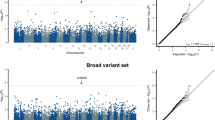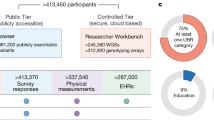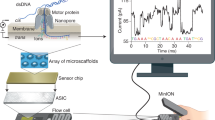Abstract
We report the analysis of a Japanese male using high-throughput sequencing to ×40 coverage. More than 99% of the sequence reads were mapped to the reference human genome. Using a Bayesian decision method, we identified 3,132,608 single nucleotide variations (SNVs). Comparison with six previously reported genomes revealed an excess of singleton nonsense and nonsynonymous SNVs, as well as singleton SNVs in conserved non-coding regions. We also identified 5,319 deletions smaller than 10 kb with high accuracy, in addition to copy number variations and rearrangements. De novo assembly of the unmapped sequence reads generated around 3 Mb of novel sequence, which showed high similarity to non-reference human genomes and the human herpesvirus 4 genome. Our analysis suggests that considerable variation remains undiscovered in the human genome and that whole-genome sequencing is an invaluable tool for obtaining a complete understanding of human genetic variation.
This is a preview of subscription content, access via your institution
Access options
Subscribe to this journal
Receive 12 print issues and online access
$209.00 per year
only $17.42 per issue
Buy this article
- Purchase on Springer Link
- Instant access to full article PDF
Prices may be subject to local taxes which are calculated during checkout




Similar content being viewed by others
References
Wellcome Trust Case Control Consortium. Genome-wide association study of 14,000 cases of seven common diseases and 3,000 shared controls. Nature 447, 661–678 (2007).
Ozaki, K. et al. Functional SNPs in the lymphotoxin-alpha gene that are associated with susceptibility to myocardial infarction. Nat. Genet. 32, 650–654 (2002).
Li, B. & Leal, S.M. Methods for detecting associations with rare variants for common diseases: application to analysis of sequence data. Am. J. Hum. Genet. 83, 311–321 (2008).
Pritchard, J.K. Are rare variants responsible for susceptibility to complex diseases? Am. J. Hum. Genet. 69, 124–137 (2001).
Gorlov, I.P., Gorlova, O.Y., Sunyaev, S.R., Spitz, M.R. & Amos, C.I. Shifting paradigm of association studies: value of rare single-nucleotide polymorphisms. Am. J. Hum. Genet. 82, 100–112 (2008).
Nejentsev, S., Walker, N., Riches, D., Egholm, M. & Todd, J.A. Rare variants of IFIH1, a gene implicated in antiviral responses, protect against type 1 diabetes. Science 324, 387–389 (2009).
Kruglyak, L. The road to genome-wide association studies. Nat. Rev. Genet. 9, 314–318 (2008).
Frazer, K.A., Murray, S.S., Schork, N.J. & Topol, E.J. Human genetic variation and its contribution to complex traits. Nat. Rev. Genet. 10, 241–251 (2009).
Tucker, T., Marra, M. & Friedman, J.M. Massively parallel sequencing: the next big thing in genetic medicine. Am. J. Hum. Genet. 85, 142–154 (2009).
Bentley, D.R. et al. Accurate whole human genome sequencing using reversible terminator chemistry. Nature 456, 53–59 (2008).
Wheeler, D.A. et al. The complete genome of an individual by massively parallel DNA sequencing. Nature 452, 872–876 (2008).
Wang, J. et al. The diploid genome sequence of an Asian individual. Nature 456, 60–65 (2008).
Levy, S. et al. The diploid genome sequence of an individual human. PLoS Biol. 5, e254 (2007).
Ahn, S.M. et al. The first Korean genome sequence and analysis: full genome sequencing for a socio-ethnic group. Genome Res. 19, 1622–1629 (2009).
Kim, J.I. et al. A highly annotated whole-genome sequence of a Korean individual. Nature 460, 1011–1015 (2009).
McKernan, K.J. et al. Sequence and structural variation in a human genome uncovered by short-read, massively parallel ligation sequencing using two-base encoding. Genome Res. 19, 1527–1541 (2009).
Li, R. et al. Building the sequence map of the human pan-genome. Nat. Biotechnol. 28, 57–63 (2010).
The International HapMap Consortium. A haplotype map of the human genome. Nature 437, 1299–1320 (2005).
Yamaguchi-Kabata, Y. et al. Japanese population structure, based on SNP genotypes from 7003 individuals compared to other ethnic groups: effects on population-based association studies. Am. J. Hum. Genet. 83, 445–456 (2008).
Abdulla, M.A. et al. Mapping human genetic diversity in Asia. Science 326, 1541–1545 (2009).
Li, H. & Durbin, R. Fast and accurate short read alignment with Burrows-Wheeler transform. Bioinformatics 25, 1754–1760 (2009).
Altschul, S.F., Gish, W., Miller, W., Myers, E.W. & Lipman, D.J. Basic local alignment search tool. J. Mol. Biol. 215, 403–410 (1990).
Simpson, J.T. et al. ABySS: a parallel assembler for short read sequence data. Genome Res. 19, 1117–1123 (2009).
Li, R. et al. De novo assembly of human genomes with massively parallel short read sequencing. Genome Res. 20, 265–272 (2010).
Zerbino, D.R. & Birney, E. Velvet: algorithms for de novo short read assembly using de Bruijn graphs. Genome Res. 18, 821–829 (2008).
Zhang, J. Rates of conservative and radical nonsynonymous nucleotide substitutions in mammalian nuclear genes. J. Mol. Evol. 50, 56–68 (2000).
Tsunoda, T. et al. Variation of gene-based SNPs and linkage disequilibrium patterns in the human genome. Hum. Mol. Genet. 13, 1623–1632 (2004).
Ng, S.B. et al. Targeted capture and massively parallel sequencing of 12 human exomes. Nature 461, 272–276 (2009).
Menashe, I. et al. Genetic elucidation of human hyperosmia to isovaleric acid. PLoS Biol. 5, e284 (2007).
Begun, D.J. & Aquadro, C.F. Levels of naturally occurring DNA polymorphism correlate with recombination rates in D. melanogaster. Nature 356, 519–520 (1992).
Charlesworth, B., Morgan, M.T. & Charlesworth, D. The effect of deleterious mutations on neutral molecular variation. Genetics 134, 1289–1303 (1993).
Chen, K. et al. BreakDancer: an algorithm for high-resolution mapping of genomic structural variation. Nat. Methods 6, 677–681 (2009).
Hirayasu, K. et al. Evidence for natural selection on leukocyte immunoglobulin-like receptors for HLA class I in Northeast Asians. Am. J. Hum. Genet. 82, 1075–1083 (2008).
Torkar, M. et al. Arrangement of the ILT gene cluster: a common null allele of the ILT6 gene results from a 6.7-kbp deletion. Eur. J. Immunol. 30, 3655–3662 (2000).
Hosono, N. et al. CYP2D6 genotyping for functional-gene dosage analysis by allele copy number detection. Clin. Chem. 55, 1546–1554 (2009).
Qin, J., Jones, R.C. & Ramakrishnan, R. Studying copy number variations using a nanofluidic platform. Nucleic Acids Res. 36, e116 (2008).
Tsend-Ayush, E. et al. Plasticity of human chromosome 3 during primate evolution. Genomics 83, 193–202 (2004).
Hillier, L.W. et al. Generation and annotation of the DNA sequences of human chromosomes 2 and 4. Nature 434, 724–731 (2005).
Haga, H., Yamada, R., Ohnishi, Y., Nakamura, Y. & Tanaka, T. Gene-based SNP discovery as part of the Japanese Millennium Genome Project: identification of 190,562 genetic variations in the human genome. Single-nucleotide polymorphism. J. Hum. Genet. 47, 605–610 (2002).
Clark, A.G., Hubisz, M.J., Bustamante, C.D., Williamson, S.H. & Nielsen, R. Ascertainment bias in studies of human genome-wide polymorphism. Genome Res. 15, 1496–1502 (2005).
McCarroll, S.A. et al. Integrated detection and population-genetic analysis of SNPs and copy number variation. Nat. Genet. 40, 1166–1174 (2008).
Alkan, C. et al. Personalized copy number and segmental duplication maps using next-generation sequencing. Nat. Genet. 41, 1061–1067 (2009).
Xie, C. & Tammi, M.T. CNV-seq, a new method to detect copy number variation using high-throughput sequencing. BMC Bioinformatics 10, 80 (2009).
Chiang, D.Y. et al. High-resolution mapping of copy-number alterations with massively parallel sequencing. Nat. Methods 6, 99–103 (2009).
Benson, G. Tandem repeats finder: a program to analyze DNA sequences. Nucleic Acids Res. 27, 573–580 (1999).
Przeworski, M., Hudson, R.R. & Di Rienzo, A. Adjusting the focus on human variation. Trends Genet. 16, 296–302 (2000).
Ashburner, M. et al. Gene ontology: tool for the unification of biology. The Gene Ontology Consortium. Nat. Genet. 25, 25–29 (2000).
Purcell, S. et al. PLINK: a tool set for whole-genome association and population-based linkage analyses. Am. J. Hum. Genet. 81, 559–575 (2007).
Siepel, A. et al. Evolutionarily conserved elements in vertebrate, insect, worm, and yeast genomes. Genome Res. 15, 1034–1050 (2005).
Acknowledgements
We thank K. Misawa for comments on the manuscript. This study was supported in part by the National Project on 'Next-generation Integrated Living Matter Simulation' of the Ministry of Education, Culture, Sports, Science and Technology (MEXT). The super-computing resource was provided by the Human Genome Center, University of Tokyo, Japan (http://sc.hgc.jp/shirokane.html).
Author information
Authors and Affiliations
Contributions
H.N., Y.N., A.F. and T.T. designed the study. A.F., T.A., M.N., K.A.B. and R.Y. performed computational analyses. A.F., T.T., H.N. and K.A.B. wrote the manuscript. K.N. performed sequencing. N.H., A.F. and K.N. performed validation experiments. H.N. and T.T. obtained funding for the study. T.T., H.N., T.S., S.M. and M.K. advised on data analysis.
Corresponding authors
Ethics declarations
Competing interests
The authors declare no competing financial interests.
Supplementary information
Supplementary Text and Figures
Supplementary Figures 1–24 and Supplementary Tables 1,6–8 (PDF 11217 kb)
Supplementary Table 2
List of non-3n deletions in coding regions (XLSX 59 kb)
Supplementary Table 3
List of deletions detected by distance between paired reads and read depth (XLSX 413 kb)
Supplementary Table 4
List of copy number gains (XLSX 64 kb)
Supplementary Table 5
List of copy number losses (XLSX 54 kb)
Rights and permissions
About this article
Cite this article
Fujimoto, A., Nakagawa, H., Hosono, N. et al. Whole-genome sequencing and comprehensive variant analysis of a Japanese individual using massively parallel sequencing. Nat Genet 42, 931–936 (2010). https://doi.org/10.1038/ng.691
Received:
Accepted:
Published:
Issue Date:
DOI: https://doi.org/10.1038/ng.691
This article is cited by
-
The landscape of viral associations in human cancers
Nature Genetics (2020)
-
Whole-genome sequence-based genomic prediction in laying chickens with different genomic relationship matrices to account for genetic architecture
Genetics Selection Evolution (2017)
-
Whole genome sequencing of Guzerá cattle reveals genetic variants in candidate genes for production, disease resistance, and heat tolerance
Mammalian Genome (2017)
-
Comparison and evaluation of two exome capture kits and sequencing platforms for variant calling
BMC Genomics (2015)
-
The impact of next-generation sequencing technologies on HLA research
Journal of Human Genetics (2015)



